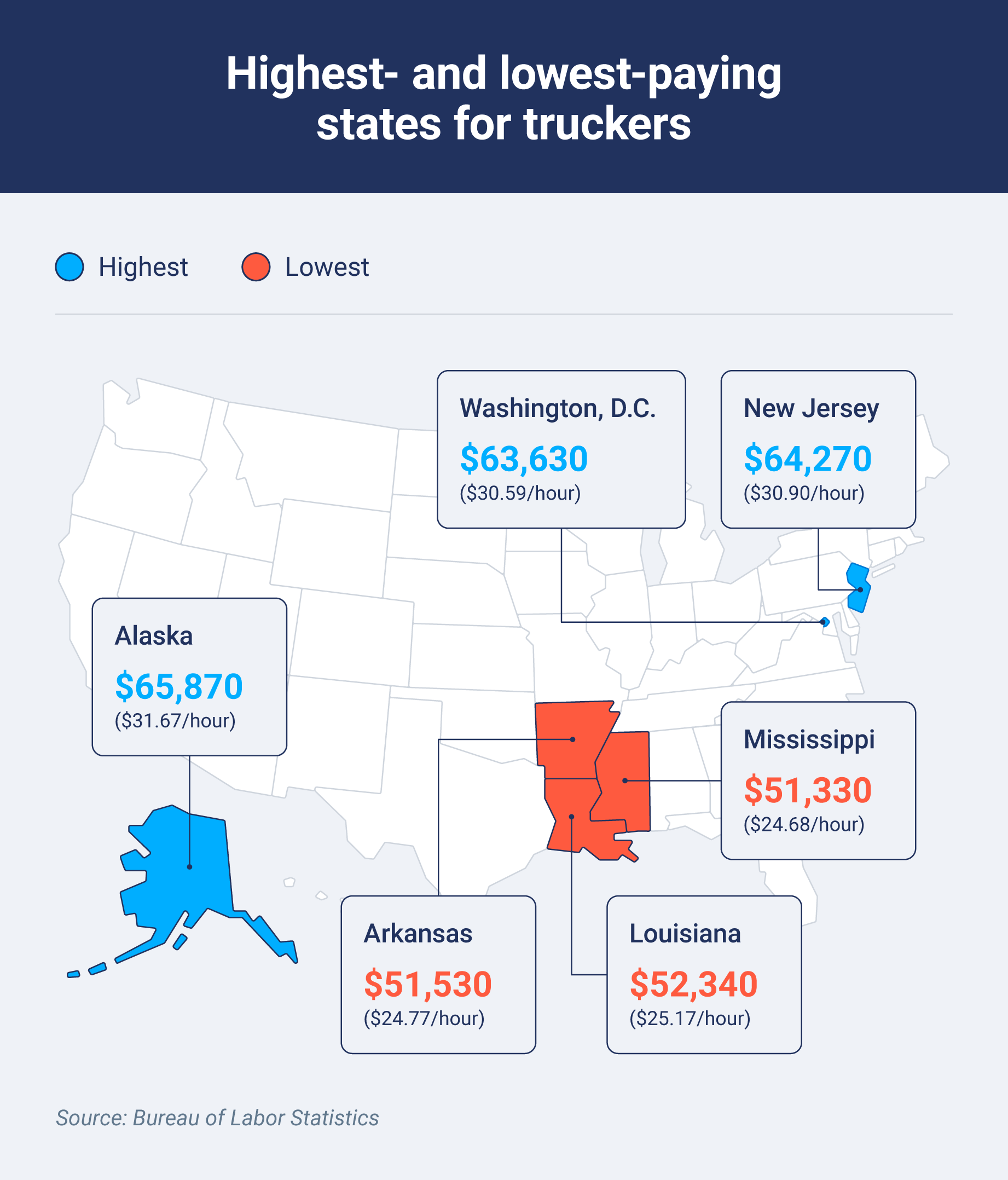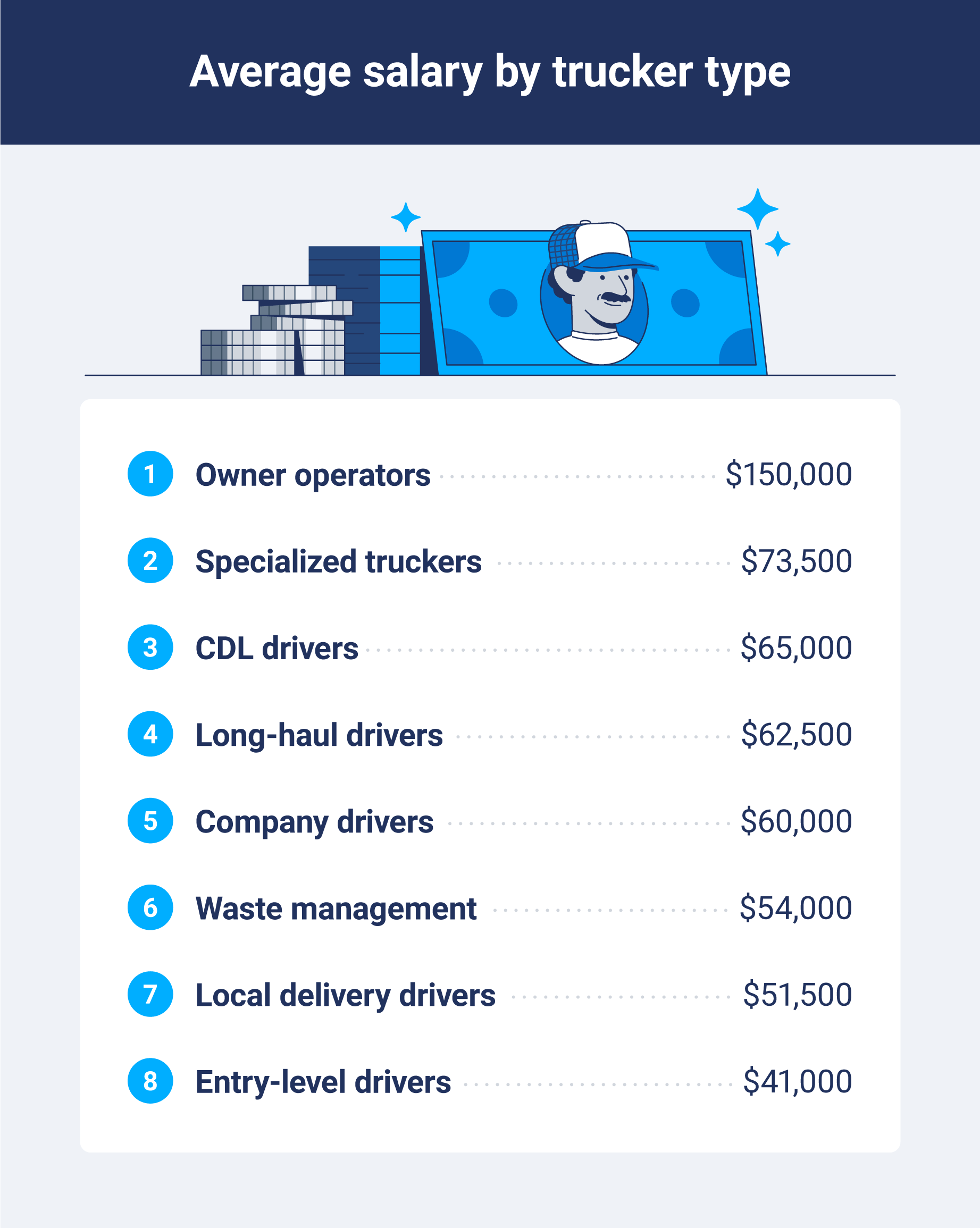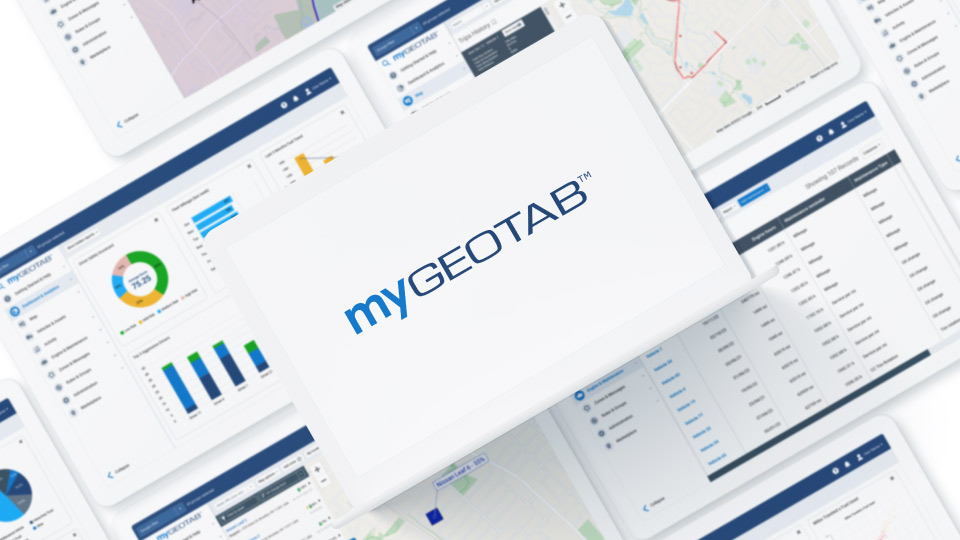Truck driver salary: 2025 guide to pay by state and job type
Fleet operators competing for skilled drivers must educate themselves on competitive truck driver salary packages, with national averages ranging from $37,440 to $76,780 annually. Strategic pay positioning can make all the difference.
By Geotab Team
Oct 31, 2025

Key Insights
- The average truck driver salary is $55,990 annually, with significantly more earning potential for experienced drivers.
- Geographic pay variations span from Mississippi’s lowest at $51,330 to Alaska’s highest $65,870.
- Specialized drivers like hazmat and tanker operators command an increased salary of 15%-35% compared to standard over-the-road (OTR) rates.
- Fleet operators must benchmark compensation against regional markets and specialized skill requirements to properly budget for salary.
According to recent trucking industry statistics, over 3.5 million drivers work in U.S. trucking.
One of the biggest draws into the world of transportation? A competitive annual wage. For fleet managers, navigating the bumpy road of the best truck driver salary to attract quality workers is just another thing on an already very long to-do list. But it’s important to get that compensation number right, as it’s the cornerstone of driver recruitment and retention.
This comprehensive breakdown walks you through national salary averages, state-by-state compensation data and how pay can vary across different trucking specialties. By using the latest Bureau of Labor Statistics (BLS) data, fleet managers can make informed decisions about how to continue attracting and maintaining top-of-the-line expertise.
What is the average truck driver salary in the U.S.?
So, how much do truck drivers make? According to the BLS, as of May 2023, heavy and tractor-trailer truck drivers make a mean annual wage of $55,990 and a mean hourly wage of $26.92.
These wages contain considerable range, as trucker salaries are based on experience and performance. The salary distribution shows:
- Bottom 10% of drivers earn up to $37,440 annually ($18/hour)
- Bottom 25% of drivers earn up to $45,920 annually ($22.08/hour)
- Middle 50% of drivers earn up to $54,320 annually ($26.12/hour)
- Top 25% of drivers earn up to $63,010 annually ($30.29/hour)
- Top 10% of drivers earn up to $76,780 annually ($36.91/hour)
Which state pays truck drivers the most?
Alaska leads the nation in truck driver salaries with the highest mean annual wage of $65,870 ($31.67/hour). Here’s how Alaska compares with other top-ranking states:
- New Jersey: $64,270 ($30.90/hour)
- Washington, D.C.: $63,630 ($30.59/hour)
- Washington state: $63,160 ($30.36/hour)
- New York: $60,910 ($29.28/hour)
The increased costs of living and the need for drivers reflect a decent truck driver yearly salary.

Truck driver salary by state
How much do truckers get paid across different states? The following is a comprehensive breakdown of truck driver annual salary by state based on the most recent BLS employment and wage data:
State | Average Annual Salary | Hourly Wage | Employment Level |
|---|---|---|---|
| Alabama | $52,760* | $25.37* | 45,800* |
| Alaska | $65,870 | $31.67 | 2,900 |
| Arizona | $53,650* | $25.80* | 27,700* |
| Arkansas | $51,530 | $24.77 | 34,400 |
| California | $58,270 | $28.02 | 204,100 |
| Colorado | $61,750 | $29.69 | 27,840 |
| Connecticut | $59,240* | $28.48* | 15,600* |
| Delaware | $56,830* | $27.32* | 3,400* |
| Florida | $52,760 | $25.37 | 101,900 |
| Georgia | $54,770* | $26.33* | 67,800* |
| Hawaii | $58,970* | $28.35* | 3,100* |
| Idaho | $55,140* | $26.51* | 12,800* |
| Illinois | $58,320* | $28.04* | 74,500* |
| Indiana | $54,330* | $26.12* | 58,700* |
| Iowa | $53,470 | $25.71 | 37,500 |
| Kansas | $54,440* | $26.17* | 26,100* |
| Kentucky | $53,800* | $25.87* | 37,000* |
| Louisiana | $52,340* | $25.17* | 28,900* |
| Maine | $56,590* | $27.21* | 8,700* |
| Maryland | $57,770* | $27.78* | 28,400* |
| Massachusetts | $60,740* | $29.20* | 26,800* |
| Michigan | $55,610* | $26.73* | 54,300* |
| Minnesota | $57,450* | $27.62* | 41,200* |
| Mississippi | $51,330* | $24.68* | 21,500* |
| Missouri | $54,800* | $26.35* | 48,900* |
| Montana | $56,000* | $26.92* | 11,700* |
| Nebraska | $58,680 | $28.21 | 24,700 |
| Nevada | $57,520* | $27.65* | 12,800* |
| New Hampshire | $58,490* | $28.12* | 6,100* |
| New Jersey | $64,270 | $30.90 | 52,500 |
| New Mexico | $54,650* | $26.27* | 10,800* |
| New York | $60,910 | $29.28 | 61,400 |
| North Carolina | $53,470* | $25.71* | 56,800* |
| North Dakota | $58,680 | $28.21 | 11,100 |
| Ohio | $55,610 | $26.73 | 89,500 |
| Oklahoma | $53,810* | $25.87* | 26,100* |
| Oregon | $58,490* | $28.12* | 22,100* |
| Pennsylvania | $56,530 | $27.18 | 89,900 |
| Rhode Island | $59,740* | $28.72* | 3,500* |
| South Carolina | $52,500* | $25.24* | 29,100* |
| South Dakota | $55,340* | $26.61* | 9,800* |
| Tennessee | $53,800* | $25.87* | 48,700* |
| Texas | $54,550 | $26.22 | 212,700 |
| Utah | $56,460* | $27.14* | 19,600* |
| Vermont | $57,840* | $27.81* | 3,400* |
| Virginia | $55,260* | $26.57* | 42,800* |
| Washington | $63,160 | $30.36 | 36,200 |
| West Virginia | $54,810* | $26.35* | 11,500* |
| Wisconsin | $57,450* | $27.62* | 41,500* |
| Wyoming | $60,030 | $28.86 | 6,200 |
| District of Columbia | $63,630 | $30.59 | 600 |
*States marked with asterisks are estimates based on regional patterns, cost of living adjustments and industry benchmarks.
Truck driver salary by type of driver
Truck driver compensation varies significantly based on experience, specialization, route types and certifications. Fleet managers must understand exactly what drives these variances to effectively manage fleet costs.
Entry-level drivers
Starting pay for truck driver yearly salaries ranges from $37,000 to $45,000 annually, reflecting the lower end of the BLS salary distribution.
New drivers often begin with local or regional routes so they can gain experience while maintaining a work-life balance. Some entry-level positions require drivers to have completed commercial driver’s license (CDL) training programs, but most don’t require extensive experience or specialized certifications.
Long-haul drivers
Long-distance truck driver salary averages between $55,000 and $70,000. OTR drivers take home premium rates because of extended time away from home. These types of positions often offer per-mile compensation, which means experienced drivers can earn more than $65,000 with the right route management and availability.
The demanding lifestyle of long-haul trucking reflects an appropriate increase in salary compared to short-haul jobs.
CDL drivers
How much do CDL drivers make, and is it worth the extra steps they must take to get an additional license? Commercial drivers who operate specialized commercial motor vehicles like tank vehicles usually earn between $58,000 and $72,000 annually.
CDL driver salaries are higher because they must undergo additional training and take on extra liability, often commanding higher compensation.

Local delivery drivers
Local delivery drivers, including those who help with last-mile delivery jobs, usually earn between $45,000 and $58,000 each year. These positions are more attractive to many drivers despite lower per-mile rates because they offer a more predictable schedule, and drivers can return to their own home each evening.
Owner operators
Independent owner operators can gross $100,000 to $200,000 annually but also face much higher expenses like vehicle maintenance, fuel, insurance and other operational expenses. Successful owner operators typically retain 60%-70% of their gross revenue after operating expenses by bolstering their budget with techniques like freight factoring.
Company drivers
Company-employed drivers typically make $52,000 to $68,000 annually, plus comprehensive benefits packages that include health insurance, retirement contributions and paid time off. Major carriers often offer competitive packages that exceed industry averages. UPS truck driver salaries, for instance, start at $70,000, and Walmart truck driver salaries start at $75,000 with benefits.
Specialized truckers
Drivers handling hazardous materials, flatbed transport, tanker operations or oversized loads can bring in between $62,000 and $85,000 annually. Since these positions require additional endorsements and specialized training and often come with higher risks, drivers receive higher compensation.
Waste management truck drivers
Garbage truck driver salary ranges fall between $48,000 and $60,000 annually. Municipal and private waste collection companies usually offer competitive benefits packages and stable, local employment with predictable schedules.
What impacts truck driver salaries?
Several key factors influence compensation levels for average truck driver salaries, including:
- Experience level: Seasoned drivers with proven reliability can earn 30% or more than the industry average. Experience directly correlates with earning potential and favorable route assignments.
- Region and cost of living: Geographic location is another significant factor when it comes to wages, with coastal states and major metropolitan areas typically offering 10% to even 50% higher compensation to offset increased living costs and retain drivers.
- Length of drive: Cross-border routes, longer hauls and specialized corridors also include additional compensation to reflect complexity, time away from home and regulatory requirements.
- Type of freight: Specialized cargo like refrigerated goods, oversized loads, high-value merchandise or hazardous materials commands premium rates due to additional handling requirements, liability considerations and specialized equipment needs.
- Company pay structure: Compensation models vary between salary plus bonus, hourly wages and per-mile rates. Each approach provides different incentives for productivity and efficiency.
- Bonuses, incentives and union representation: Safety bonuses, fuel efficiency incentives, referral programs and union-negotiated contracts often add an additional $5,000-$15,000 to base compensation packages, bolstering desired performance behaviors.
Power higher driver earnings with better fleet management
Strategic fleet optimization through advanced telematics means fleet operators can create the conditions drivers need to maximize their earning potential and improve operational efficiency. Modern telematics handle route optimization, hours of service and vehicle health metrics automatically, making it easy to optimize routes and implement performance-based incentives.
For fleet operators looking to improve their driver retention programs, implementing advanced telematics solutions is a win-win. Ready to get started? Geotab’s advanced telematics tool helps you measure fleet productivity to take your operations to the next level, optimizing everything from driver behavior to salaries.
Subscribe to get industry tips and insights
Frequently Asked Questions
Alaska is the highest-paying state for truck drivers, with annual salaries averaging $65,870 ($31.67/hour).
Yes, experienced drivers in specialized roles like long-haul drivers or hazmat specialists, owner operators or those working with major carriers can earn $100,000+ annually.
The average salary range for a truck driver with a specialization, like a hazmat driver, is $64,000 to $119,000 annually.
Trucker compensation models vary between employers. Long-haul drivers often receive per-mile rates, local drivers usually earn hourly and some specialized roles offer salary plus bonus structures or even percentage-of-load compensation models.
The Geotab Team write about company news.
Table of Contents
Subscribe to get industry tips and insights
Related posts
.jpg)
Go beyond reactive truck maintenance with predictive solutions that drive profits
December 8, 2025
3 minute read

The $4B Crisis: Video Intelligence as the Answer to Fleet Distraction
December 2, 2025
3 minute read

14 Fleet management key performance indicators you should track to boost efficiency
December 1, 2025
7 minute read

The True Cost of Cargo Theft: When Customer Trust is on the Line
November 24, 2025
2 minute read


Telematics device cost: Key factors that determine pricing
November 19, 2025
5 minute read